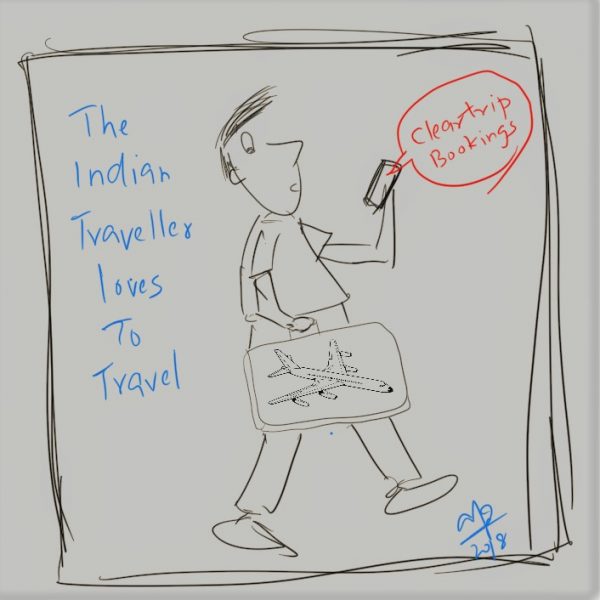There was nothing of the likes of the Google India-BCG Report in the mid-nineties to help me decide the intricacies of my travel plans. Specky was to fly to London as a Commonwealth scholar and a month later my son and I were to join her at York. Besides all the excited syllables floating around, there was the complex task of getting air-tickets.
‘How?’ asked Specky.
I said, ‘Let me call a friend who has a friend who is related to someone working for a travel agency in Gole market. I think this is better than visiting these agents alone and getting fleeced.’ This was the way most Indians thought then. It took just a few years for computers and the internet to magically change everything. Well, not just the actions and words of potential travelers but also the speed at which transactions happen. I am certainly not surprised to read in an article published in the Economic Times that the “Indian travel market is projected to grow at 11-11.5% to $48 billion by 2020 with the biggest contributor, air travel expected to grow at 15% to $30 billion. Hotels will grow at 13% to $13 billion by 2020 while railways will remain largely stagnant at $5 billion.”
The way travel booking has changed is nothing short of a modern-day fairy tale with smartphones, tablets, apps, laptops, desktops, artificial intelligence, and online chats coming together like magical characters bubbling with goodness and enthusiasm. The quote by The Indian Digital Traveller Research by Travelport in Financial Express published in November, 2017 points out that “Indians have been termed as the most digitally-savvy travellers. The study indicates that 71% travellers use smartphones for research and booking while 82% appreciate digital boarding passes and e-tickets. Indian travellers are also avid social media users — with 87% using pictures and videos posted by friends as part of their travel research; and about nine out of 10 travellers valuing user reviews.”
What does all this really translate into? Well, I’d say that Indians are now no longer just travelers but have evolved into becoming savvy online travelers. We are now the sort who will have several touch points in our travel-planning and booking journey and one that will include OTA, search engines, and maps. This journey from the mid-nineties to the present has seen a growth in domestic tourism grow by 10 times and I quote the Market Research and Statistics by Ministry of Tourism as informing that the rise has been from 160 million to 1,614 million. By the way, the same report also mentions that even foreign tourist arrivals have hopped from 5.5 million to 25 million between 1997 and 2016.
Ever since the online travel portals have emerged, even my travel booking pattern has slowly moved away from trying to find friends of friends working in travel agencies and having absolute faith on online portals like Cleartrip. Of course, there are plenty of others out there and I do tend to touch them all in the hope of finding price points that might surprise me but Cleartrip hasn’t yet disappointed me. These people are clearly customer-centric focused entirely on offering not just convenience but also competitive pricing that normally has a winning edge. One of their senior executives told me once during a telephonic conversation that their aim was primarily to “offer attractive deals and discounts on tickets and a bouquet of other features like train booking, hotel booking, car rental and booking local activities and experiences. No doubt,” he went on, “ours is a complete travel planning and booking solution.”
Conversations with executives and sales gimmicks apart, my personal experience tells me to trust price comparison charts first and Cleartrip doesn’t disappoint here as well. I have been indulging in a lot of travel-oriented activity on this portal that includes checking flight schedules, timing the booking of a ticket, doing a retro-search to find opaque instances in claims of transparency, and even making notes of cost of holidaying and comparing my notes of one year with newer notes an year later. These actions may sound funny but are vital in converting a customer into a loyal customer and Cleartrip doesn’t seem to falter even once. I’ve always found them trustworthy in matters of price, wide-horizoned in choice of airlines, helpful with information on layover durations and flight durations, and the entire process is always without nervous twitches and jerks. I obviously mean that all these facilities are for times when I am travelling abroad and even while flying within the country.
Indian travelers, I must admit, are not the sort who will take inconsistencies in pricing, service, and offers without a protest and this, I guess, is what makes them good customers. Their actions ensure that there is a continual evolution in the quality of service that online travel portals weave into their business model and organizational strategy. Indian travelers have taught online travel portals vital lessons in how to survive competition and I am sure this equation isn’t poised to change anytime soon.
.
.
.
.
.
.
Arvind Passey
31 May 2018









